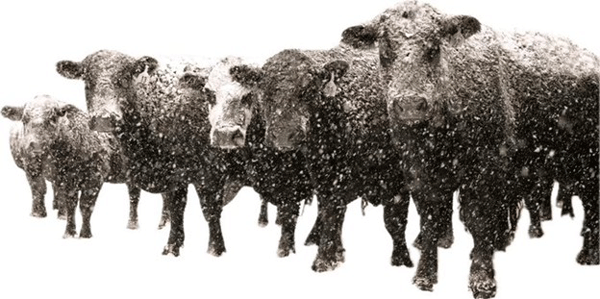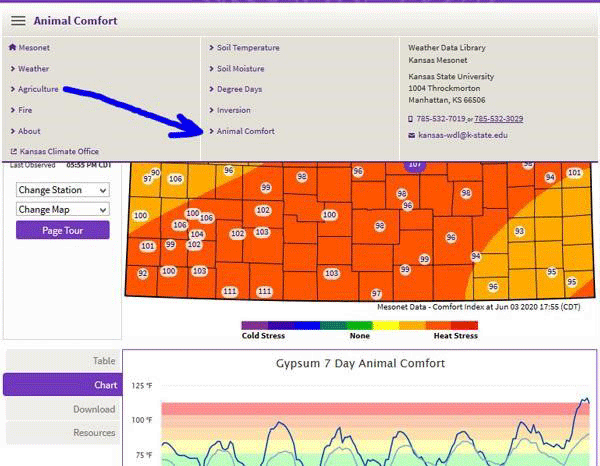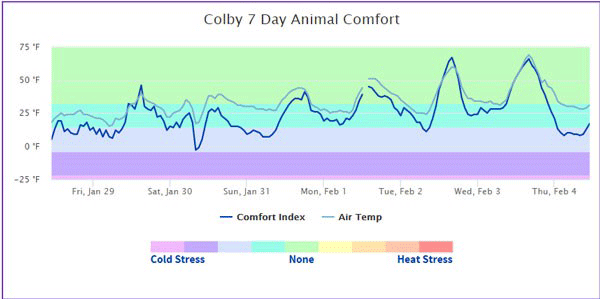The winter of 2023-2024 has been mild thus far, but much colder conditions are in the forecast. These much colder conditions will likely negatively impact cattle, particularly calves (Figure 1). To aid producer management decisions, a cattle comfort tool on the Kansas Mesonet can be found at https://mesonet.ksu.edu/agriculture/animal. This tool can aid in decision management with the evaluation of current conditions and even the seven-day forecast. Both are critical as the recent warmer-than-normal temperatures have not allowed cattle to adjust to colder conditions. Additionally, with calving season approaching – increased proactive measures may be required to minimize potential loss.
Users can access this tool from either the main Mesonet page at the link above or by selecting from the drop-down menu Agriculture and then Animal Comfort (Figure 2).

Figure 1. Cattle in the snow. Photo used with permission; source: twitter.com/MarkRMcIntsh).

Figure 2. Screenshot of the menu path to the Comfort Index page on the Kansas Mesonet.
Utilizing the Forecast Animal Comfort Index
This product utilizes the National Weather Service hourly forecast (averaged over the hour, meaning extremes could be slightly more) for the next seven days. This data consisting of solar, wind, temperature, and humidity is utilized in the Comprehensive Comfort Index equation from the University of Nebraska. The ability to handle both hot and cold extremes provides a year-round product to increase producer awareness in advance of critical weather. Data is displayed on a graph and a summarized table (Figure 3), allowing quick analysis of conditions on desktop and mobile browsers in an easy-to-read format.

Figure 3. The Forecast Animal Comfort as found on the Mesonet in advance of the mid-January cold snap.
It is important to note that the forecast is only a guidance product. Forecasts are subject to change, and conditions could vary significantly based on numerous external factors. Actual animal response to temperature stress will depend on several factors not accounted for in the index. Those include but are not limited to age, hair coat (winter vs. summer; wet vs. dry), health, body condition, micro-environment, and acclimatization. Additionally, recent moisture has also resulted in mud which increases stress levels for livestock.
Tracking conditions with current data
One of the most basic ways to verify a forecast is to look at current conditions. The original Animal Comfort product remains to allow producers to see the real-time weather stress at the nearest Mesonet location. This displays both the current data up to (fifteen-minute intervals).
Users can scroll down the page and view the previous seven days' hourly data on the “Chart” (Figure 4). This is particularly useful for producers that suffered loss and want to capture the conditions that took place in the previous week. You can also download the data in a comma-delimited form for use in Excel or similar software. This can be found under the “Download” tab.
No historical data download is available beyond the last seven days, so this information must be captured quickly.

Figure 4. Animal Comfort Index history at Colby Mesonet station. Graphic from Kansas Mesonet.
The displayed data does not consider conditions compared to “normal.” Solar radiation, wind, and humidity data are hard to put into a climatological (or long-term) perspective since recorded data is relatively new (only about 15 years of data at most stations). Thus, climatological data is limited for the animal comfort index. If you need historical data, please reach out to our staff at Kansas-wdl@ksu.edu, and we’d be glad to pull older data that may exist.
If you want to read more about the Forecast or Current Conditions pages, please visit https://mesonet.ksu.edu/agriculture/animal and scroll down to the “Resources” tab.
Christopher “Chip” Redmond, Kansas Mesonet Manager
christopherredmond@ksu.edu
Tags: Mesonet livestock Cattle Comfort Tool cold temperatures extreme weather